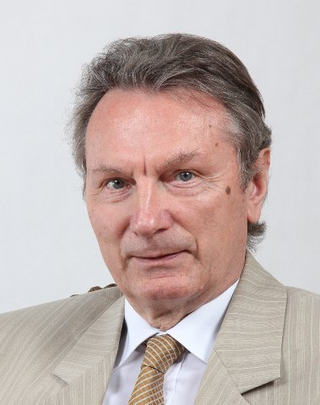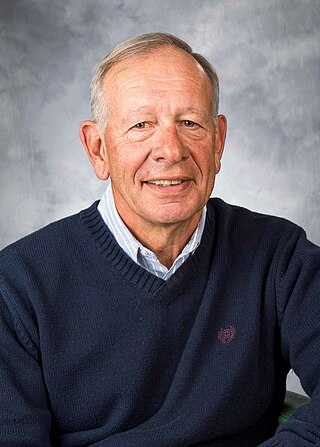The following outline is provided as an overview of and topical guide to software engineering:

A metamodel is a model of a model, and metamodeling is the process of generating such metamodels. Thus metamodeling or meta-modeling is the analysis, construction, and development of the frames, rules, constraints, models, and theories applicable and useful for modeling a predefined class of problems. As its name implies, this concept applies the notions of meta- and modeling in software engineering and systems engineering. Metamodels are of many types and have diverse applications.

Hardware acceleration is the use of computer hardware designed to perform specific functions more efficiently when compared to software running on a general-purpose central processing unit (CPU). Any transformation of data that can be calculated in software running on a generic CPU can also be calculated in custom-made hardware, or in some mix of both.
Shimon Y. Nof is a professor of Industrial Engineering at Purdue University in West Lafayette, Indiana. He has held visiting positions at the Massachusetts Institute of Technology and at universities in Chile, the European Union, Hong Kong, Israel, Japan, Mexico, Philippines, Taiwan, and UK. He is the Director of the Production, Robotics and Integration Software for the Manufacturing & Management (PRISM) Center at Purdue.
The Generic Modeling Environment (GME) is a domain-specific, model-integrated program synthesis tool for creating domain-specific models of large-scale systems. GME development started in 2000 at Vanderbilt University, US and continues well into 2022. Initially it only supported MS Windows OS, but later evolved into WebGME, a web- and Node.js- based software. Its primary purpose is model-building.
The Advanced Learning and Research Institute (ALaRI), a faculty of informatics, was established in 1999 at the University of Lugano to promote research and education in embedded systems. The Faculty of Informatics within very few years has become one of the Switzerland major destinations for teaching and research, ranking third after the two Federal Institutes of Technology, Zurich and Lausanne.
Market engineering comprises the structured, systematic and theoretically founded procedure of analyzing, designing, introducing and also quality assuring of markets as well as their legal framework regarding simultaneously their market mechanisms and trading rules, systems, platforms and media, and their business models. In this context, term market stands for a set of rules defining the exchange of information between participants to conduct transactions at minimized cost. Market Engineering borrows concepts and methods from Economics, particularly, Game Theory, and Mechanism Design concepts, but also borrows concepts from Finance, Information Systems and Operations Research. It finds particular application in the context of electronic market platforms.
Cyber-Physical Systems (CPS) are control systems that integrate computation and physical processes, with embedded computers and networks monitoring and controlling physical systems in real-time. In cyber-physical systems, physical and software components are deeply intertwined, able to operate on different spatial and temporal scales, exhibit multiple and distinct behavioral modalities, and interact with each other in ways that change with context. CPS involves transdisciplinary approaches, merging theory of cybernetics, mechatronics, design and process science. The process control is often referred to as embedded systems. In embedded systems, the emphasis tends to be more on the computational elements, and less on an intense link between the computational and physical elements. CPS is also similar to the Internet of Things (IoT), sharing the same basic architecture; nevertheless, CPS presents a higher combination and coordination between physical and computational elements.
An Executable Architecture (EA), in general, is the description of a system architecture in a formalnotation together with the tools that allow the automatic or semi-automatic generation of artifacts from that notation and which are used in the analysis, refinement, and/or the implementation of the architecture described.

Dr.Vladimír Székely was a Hungarian electrical engineer, professor emeritus at the Budapest University of Technology and Economics and a corresponding member of the Hungarian Academy of Sciences. He was Head of Department of Electron Devices at the Budapest University of Technology and Economics between 1990 and 2005. He published research results in 360 peer-reviewed papers listed in Web of Science, the most cited being referenced over 200 times, along with 12 books or book-chapters based on his theoretical and practical results.
Knowledge-based configuration, also referred to as product configuration or product customization, is an activity of customising a product to meet the needs of a particular customer. The product in question may consist of mechanical parts, services, and software. Knowledge-based configuration is a major application area for artificial intelligence (AI), and it is based on modelling of the configurations in a manner that allows the utilisation of AI techniques for searching for a valid configuration to meet the needs of a particular customer.
Stephanie Forrest is an American computer scientist and director of the Biodesign Center for Biocomputing, Security and Society at the Biodesign Institute at Arizona State University. She was previously Distinguished Professor of Computer Science at the University of New Mexico in Albuquerque. She is best known for her work in adaptive systems, including genetic algorithms, computational immunology, biological modeling, automated software repair, and computer security.
Software intelligence is insight into the inner workings and structural condition of software assets produced by software designed to analyze database structure, software framework and source code to better understand and control complex software systems in information technology environments. Similarly to business intelligence (BI), software intelligence is produced by a set of software tools and techniques for the mining of data and the software's inner-structure. Results are automatically produced and feed a knowledge base containing technical documentation and blueprints of the innerworking of applications, and make it available to all to be used by business and software stakeholders to make informed decisions, measure the efficiency of software development organizations, communicate about the software health, prevent software catastrophes.
System-level simulation (SLS) is a collection of practical methods used in the field of systems engineering, in order to simulate, with a computer, the global behavior of large cyber-physical systems.

Larry E. Druffel is an American engineer, Director Emeritus and visiting scientist at the Software Engineering Institute (SEI) at Carnegie Mellon University. He has published over 40 professional papers/reports and authored a textbook. He is best known for leadership in: (1) bringing engineering discipline and supporting technology to software design and development, and (2) addressing network and software security risks.
Rajesh K. Gupta is a computer scientist and engineer, currently the Qualcomm Professor in Embedded Microsystems at University of California, San Diego. His research concerns design and optimization of cyber-physical systems (CPS). He is a Principal Investigator in the NSF MetroInsight project and serves as Associate Director of the Qualcomm Institute. His research contributions include SystemC and SPARK Parallelizing High-level Synthesis. Earlier he led NSF Expeditions on Variability in Microelectronic circuits.

David Atienza Alonso is a Spanish/Swiss scientist in the disciplines of computer and electrical engineering. His research focuses on hardware‐software co‐design and management for energy‐efficient and thermal-aware computing systems, always starting from a system‐level perspective to the actual electronic design. He is a full professor of electrical and computer engineering at the Swiss Federal Institute of Technology in Lausanne (EPFL) and the head of the Embedded Systems Laboratory (ESL). He is an IEEE Fellow (2016), and an ACM Fellow (2022).
Ragunathan "Raj" Rajkumar is the George Westinghouse Professor of Electrical and Computer Engineering at Carnegie Mellon University in Pittsburgh, Pennsylvania. He is also affiliated with the Robotics Institute and the Heinz School of Information Systems and Public Policy at Carnegie Mellon University. He also serves as the Director of the Metro21 Smart Cities Institute and as the Director of the Mobility21 USDOT National University Transportation Center at Carnegie Mellon University. He also leads the General Motors-CMU Connected and Autonomous Driving Collaborative Research Laboratory (CAD-CRL), and the Real-Time and Multimedia Systems Lab (RTML) there.

Arthur Frank Witulski is an American electrical engineer. He is the Research Associate Professor Electrical Engineering and Computer Science at Vanderbilt University, where his research activities focus on microelectronics and semiconductor devices. He is affiliated with the Radiation Effects and Reliability Group at Vanderbilt University, where he works on the effects of radiation on semiconductor devices and integrated circuits. He also serves as an engineer at the Institute for Space and Defense Electronics at Vanderbilt. He is best known for his work in the field of Power electronics and ionizing radiation response of DC-to-DC converter.
Birgit Vogel-Heuser is a German computer scientist and professor at The Technical University of Munich (TUM). She has been cited over 12,000 times. Vogel-Heuser's research focuses on systems and software engineering, and modeling of distributed embedded systems.






